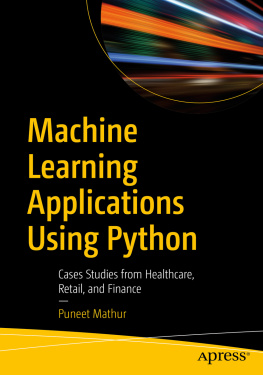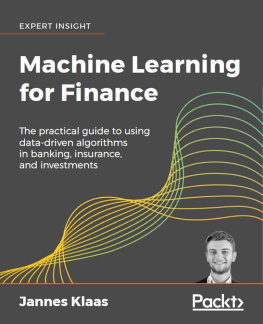Puneet Mathur
Bangalore, Karnataka, India
Any source code or other supplementary material referenced by the author in this book is available to readers on GitHub via the books product page, located at www.apress.com/978-1-4842-3786-1 . For more detailed information, please visit http://www.apress.com/source-code .
ISBN 978-1-4842-3786-1 e-ISBN 978-1-4842-3787-8
https://doi.org/10.1007/978-1-4842-3787-8
Library of Congress Control Number: 2018965933
Puneet Mathur 2019
This work is subject to copyright. All rights are reserved by the Publisher, whether the whole or part of the material is concerned, specifically the rights of translation, reprinting, reuse of illustrations, recitation, broadcasting, reproduction on microfilms or in any other physical way, and transmission or information storage and retrieval, electronic adaptation, computer software, or by similar or dissimilar methodology now known or hereafter developed.
Trademarked names, logos, and images may appear in this book. Rather than use a trademark symbol with every occurrence of a trademarked name, logo, or image we use the names, logos, and images only in an editorial fashion and to the benefit of the trademark owner, with no intention of infringement of the trademark. The use in this publication of trade names, trademarks, service marks, and similar terms, even if they are not identified as such, is not to be taken as an expression of opinion as to whether or not they are subject to proprietary rights.
While the advice and information in this book are believed to be true and accurate at the date of publication, neither the authors nor the editors nor the publisher can accept any legal responsibility for any errors or omissions that may be made. The publisher makes no warranty, express or implied, with respect to the material contained herein.
Distributed to the book trade worldwide by Springer Science+Business Media New York, 233 Spring Street, 6th Floor, New York, NY 10013. Phone 1-800-SPRINGER, fax (201) 348-4505, e-mail orders-ny@springer-sbm.com, or visit www.springeronline.com. Apress Media, LLC is a California LLC and the sole member (owner) is Springer Science + Business Media Finance Inc (SSBM Finance Inc). SSBM Finance Inc is a Delaware corporation.
Introduction
The idea of writing this book came up when I was planning a machine learning workshop in Bangalore in 2016. When I interacted with people, I found out that although many said they knew machine learning and had mostly learned it through self-study mode, they were not able to answer interviewers questions on applying machine learning to practical business problems. Even some of the experienced machine learning professionals said they had implementation experience of computer vision in a particular area like manufacturing; however, they did not have the experiential knowledge on how it can be applied in other domains.
As of the writing of this book, the three most progressive and promising areas for implementation are healthcare, retail, and finance. I call them promising because there are some applications that have been built in areas like healthcare (e.g., with expert robotic processes like surgical operations); however, there are more applications that are being discovered every day. Retail affects everyday lives of everybody on this planet, as you need to shop for your personal needs. Whether you buy from a grocery store or a retail chain, online machine learning and artificial intelligence is going to change the customer experience by predicting their needs and making sure the right solutions are available at the right time. Finance is another area that holds a lot of promise and has seen less application of machine learning and artificial intelligence in comparison to the other sectors. The primary reason for that is because it is the sector with the maximum regulations and law enforcement taking place heavily here. It is also the sector which forms the backbone of the economy. Without finance, there is no other sector that can operate.
Readers, be they those who are just starting off with machine learning or with experience in Python and machine learning implementation in projects other than these sectors, will definitely gain an experiential knowledge that I share with you the through the case studies presented in this book. The reader will get motivation from my famous quote on artificial intelligence and machine learning it is not the Artificial Intelligence but the Human Intelligence behind the Artificial Intelligence that is going to change the way we live our lives in the future.
There are three sections in this book, and I think each of these could have been printed as separate books in themselves. The good thing that the reader will find is that the structure of these three sections is identical. Each section starts off with an overview section where you will understand the current scenarios for that segment, such as healthcare, retail, or finance. Then there is the technological advancement chapter common to all the three segments, where the state of machine learning has been discussed in detail. It is also the section where I present to you the results of the Delphi Method expert survey for each of those domains. Then there is a chapter on how to implement machine learning in that particular domain. This is where you will learn how to use an industry-emulated or modeled data set and how to implement it using Python code, step-by-step. Some of this code and approach you will be able to directly apply in your project implementations. In each section, you will find two case studies taken from practical business problems, again modeled on some of the practical business problems that are commonly faced by businesses in that industry segment. Each case study is unique and has its own questions that you must carefully study and try to answer independently. I have given the solution for only one of the case studies using Python code, and I have let the second case study in each section be a discussion-only solution. The reason for doing this is because I want you to apply your own mind to solve them after looking at how I have solved the first one. Please remember each business is different, and each solution has to also be different. However, the machine learning approach does not differ much.
I know for sure that many of you who read this book are highly experienced machine learning professionals in your field and that is why you are looking for expert advice on how to avoid common gotchas or pitfalls during machine learning in that domain, such as healthcare or retail or finance. Each sector has its own set of pitfalls, as the nature of the business is very different.
There could be many readers who could belong to the startup eco-system and would like to get new ideas on implementation of machine learning and artificial intelligence in these areas. In each of the three sections, you will find three innovative ideas that I present to you that you could immediately take and start implementing.
If you are looking for a book that gives you experiential and practical knowledge of how to use Python and solve some of the problems in the real world, then you will be highly satisfied.















